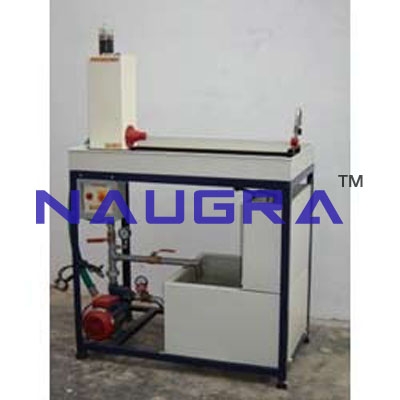- Civil Lab Mechanical Lab Engineering Lab Equipments
- sales@didacticlabequipments.com

CAT NO: DIDACTICNLE-Export-205059
EXERCISES AND PRACTICAL POSSIBILITIES
Some Practical Possibilities of the Unit:
1.- Load loss by friction in a rough pipe of 17 mm of interior diameter.
2.- Load loss by friction in a rough pipe of 23 mm of interior diameter.
3.- Load loss by friction in a smooth pipe of 6.5 mm of interior diameter.
4.- Load loss by friction in a smooth pipe of 16.5 mm of interior diameter.
5.- Load loss by friction in a smooth pipe of 26.5 mm of interior diameter.
6.- Influence of the diameter in the load loss by friction in rough pipes.
7.- Influence of the diameter in the load loss by friction in smooth pipes.
8.- Load loss by friction in smooth and rough pipes.
9.- Friction coefficient in a rough pipe of 17 mm of interior diameter.
10.-Friction coefficient in a rough pipe of 23 mm of interior diameter.
11.-Friction coefficient in a smooth pipe of 6.5 mm of interior diameter.
12.-Friction coefficient in a smooth pipe of 16.5 mm of interior diameter.
13.-Friction coefficient in a smooth pipe of 26.5 mm of interior diameter.
14.-Influence of the diameter in the friction coefficient in rough pipes.
15.-Influence of the diameter in the friction coefficient in smooth pipes.
16.-Friction coefficient in smooth and rough pipes.
17.-Load losses in the inclined seat valve.
18.-Load losses in the floodgate valve.
19.-Load losses in the filter.
20.-Load losses in the membrane valve.
21.-Load losses in an abrupt broadening.
22.-Load losses in the venturimeter
23.-Load losses in the diaphragm.
24.-Load losses in an abrupt contraction.
25.-Load losses in the accessories.
26.-Flow measurements by load loss in a venturimeter.
27.-Flow measurements by load loss in a diaphragm.
28.-Flow measurements by means of load loss.
29.-Load losses in a symmetrical bifurcation.
30.-Load losses after two 90º elbows.
31.-Load losses in a T-junction.
32.-Load losses for a 90º elbows.
33.-Load losses on the ball valve.
34.-Load losses for an elbow of 45º.
35.-Load losses in a inclined T-junction.
36.-Study of laminar regime.
37.-Study of turbulent regime.
Other possible practices:
38.-Sensors calibration.
Practices to be done by PLC Module (PLC-PI)+PLC Control Software:
39.-Control of the AFTC unit process through the control interface box without the computer.
40.-Visualization of all the sensors values used in the AFTC unit process.
41.-Calibration of all sensors included in the AFTC unit process.
42.-Hand on of all the actuators involved in the AFTC unit process.
43.-Realization
of different experiments, in automatic way, without having in front the
unit. (This experiment can be decided previously).
44.-Simulation
of outside actions, in the cases do not exist hardware elements.
(Example: test of complementary tanks, complementary industrial
environment to the process to be studied, etc).
45.-PLC hardware general use and manipulation.
46.-PLC process application for AFTC unit.
47.-PLC structure.
48.-PLC inputs and outputs configuration.
49.-PLC configuration possibilities.
50.-PLC program languages.
51.-PLC different programming standard languages (literal structured, graphic, etc.).
52.-New configuration and development of new process.
53.-Hand on an established process.
54.-To visualize and see the results and to make comparisons with the AFTC unit process.
55.-Possibility of creating new process in relation with the AFTC unit.
56.-PLC Programming Exercises.
57.-Own PLC applications in accordance with teacher and student requirements. Fluid Mechanics Lab Equipments manufacturers.
